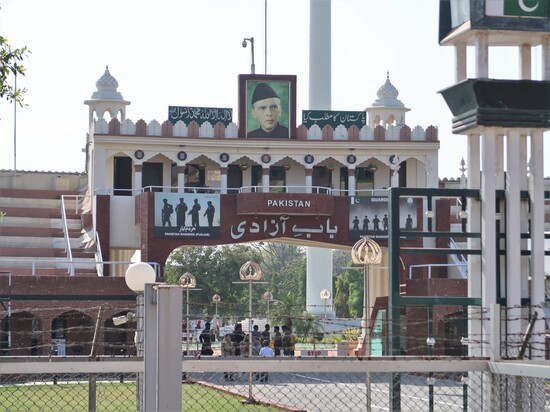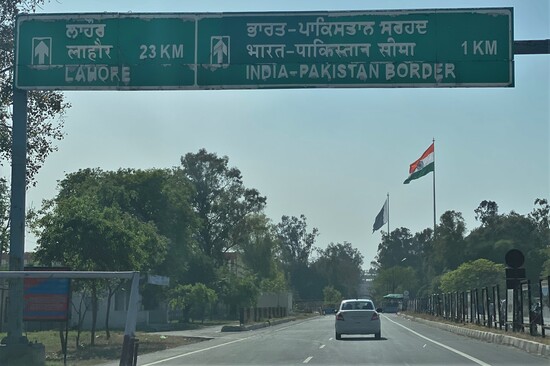Mention the word “Pakistan†and danger and/or violence are pretty much the only things that come up for me. I couldn’t tell you any good things about Pakistan, likely because I’ve never taken the time to challenge my initial perception of the country; an impression formed over the years from listening in on adult conversations as a child and watching the news on TV as a young adult. This belief was reinforced when we joined the State Department in 2009 and I learned that posts in Pakistan didn’t allow family members below 21 to go there. True or not, that’s what I’d come to believe. Given my negative view, you would assume I’d stay as far away from there as possible.

And yet, there I was, sitting a mere 30 feet from the border of Pakistan, watching a light-hearted joint ceremony transpiring between the Indian and Pakistani border security guards at the Wagah-Attari border in Punjab, which happens to be the only place you can cross on land between India and Pakistan. Amazingly, this ceremony has been happening daily since the border officially closed in 1959. To truly understand this place though, we need to go all the way back to 1947, the year India was granted its independence from Great Britain.

Full disclosure first. I’m not a history expert, but this is how I understand things to have transpired. Britain, weakened and bankrupt after the war, finally conceded to India’s demands and decolonized the British Raj in August of 1947. Religious tensions had been growing between Muslims and Hindus in the years leading up to 1947. During independence talks, the All-Indian Muslim League—formed in 1906 to protect and advocate for the rights of Muslims in British India—began advocating for separate Hindu and Muslim states. Their advocacy proved successful and eventually the Indian National Congress, the main party of Hindus at the time, agreed that British India could be partitioned into 3 pieces—West Pakistan (now Pakistan), India, and East Pakistan (now Bangladesh). East and West Pakistan were to be designated as Muslim-majority states and India would have a Hindu majority. To be “impartial,†a British judge named Cyril Radcliffe was chosen to draw the official boundary lines between the newly-created states.

On the Western side of British India, Radcliffe drew the line right down the middle of Punjab, just between Lahore and Amritsar. Anything west of the line became West Pakistan. In the Eastern part of British India, the new line split Bengal into two parts, with the easternmost part becoming East Pakistan (later Bangladesh). On August 17th the new lines were announced and confusion reigned. Actually, confusion undersells it. Fearing persecution by the new majority religion of their demarcated state, those who found themselves on the “wrong†side (for example, Hindus who had been residing in Punjab west of the new line) scrambled to migrate to the state that corresponded to their religion. The plan’s architects assumed everyone would stay put and were blindsided and hugely unprepared for a mass migration.
Up until the mid-1940s, Hindus, Muslims, Sikhs, Jains, Buddhists, Christians, Parsis, Jews, and others had been coexisting more or less peaceful-ishly for a couple centuries in regions across South Asia. Things began to change in India leading up to and after WWII as religion and politics became more intertwined and violence against religious groups became more common. Tensions were especially high in Punjab and when the new state lines were announced, inter-communal violence and rioting broke out along both sides of the new India-Pakistan border. Violence against religious minorities grew so bad, in fact, that many felt they had no choice. Therefore, in the final months of 1947, it is estimated that between 10 and 15 million refugees crossed the newly -partitioned borders to join what they hoped would be the safety of their religious majority. Sadly, during that migration, estimates are that between one and two million religious minorities were killed while trying to make the crossing to their new designated state. This is where you hear stories about whole trainloads of refugees being slaughtered as they tried to flee. This was the true beginning of the India-Pakistan conflict, a perfect storm created out of the growing fear and paranoia in communities and the breakdown in law and order as the governments transitioned from British to independent rule.
Over the next 75 years, things didn’t get a whole lot better. In 1971, East Pakistan became Bangladesh after a contested national election and military intervention/liberation from India. In the early 1990s, the disputed state of Kashmir saw a rash of violence against Hindus, violence that was widely believed to have been supported by Pakistan. Then, in 2008, Pakistan-supported terrorists attacked Mumbai. Pakistan, meanwhile, accused India of fomenting unrest in Pakistan.
And that doesn’t even take into account the Sikhs, the majority of whom resided in Punjab, also the site of their most sacred shrine, The Golden Temple. Some Sikhs were violent separatists who wanted their own country, and while there were conflicting reports about whether or not they were supported by Pakistan, the conflict ultimately led to the assassination of an Indian Prime Minister by her Sikh bodyguards after the Indian army attacked Sikh separatists holed up in the Golden Temple in Amritsar. So, as you can see, it’s all very messy and complicated with strong feelings on both sides.
Which brings us back the border ceremony, which I’ll elaborate on in my next post since this one has gotten ridiculously long. See you back here in a day or two!


